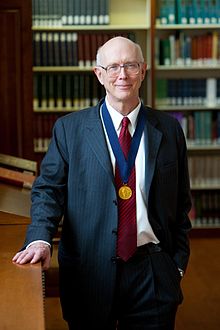George McClelland Whitesides (born August 3, 1939) is an American chemist and professor of chemistry at Harvard University. He is best known for his work in the areas of nuclear magnetic resonance spectroscopy, organometallic chemistry, molecular self-assembly, soft lithography,[3] microfabrication, microfluidics, and nanotechnology. A prolific author and patent holder who has received many awards, he received the highest Hirsch index rating of all living chemists in 2011.[4][5][6]
- ^ ST. FLEUR, NICHOLAS (November 6, 2016). "John D. Roberts Dies at 98; He Revolutionized the Field of Organic Chemistry". The New York Times. Retrieved February 1, 2018.
- ^ Weiss, P. S. (2007). "A Conversation with Prof. George M. Whitesides: Pioneer in Soft Nanolithography". ACS Nano. 1 (2): 73–78. doi:10.1021/nn700225n. PMID 19206522.
- ^ Xia, Y.; Whitesides, G. M. (1998). "Soft Lithography". Annual Review of Materials Science. 28 (5): 153–184. Bibcode:1998AnRMS..28..153X. doi:10.1146/annurev.matsci.28.1.153. PMID 29711088.
- ^ "H-index ranking of living chemists" (PDF). Chemistry World. December 12, 2011.
- ^ George M. Whitesides publications indexed by the Scopus bibliographic database. (subscription required)
- ^ George M. Whitesides publications indexed by Google Scholar
